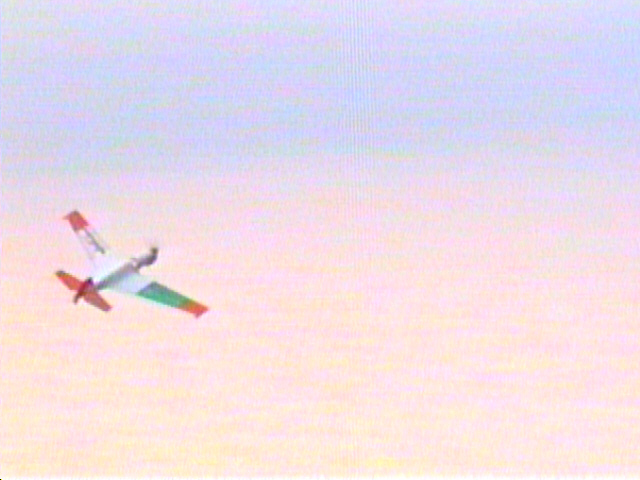
IT FLIES!

IT FLIES!
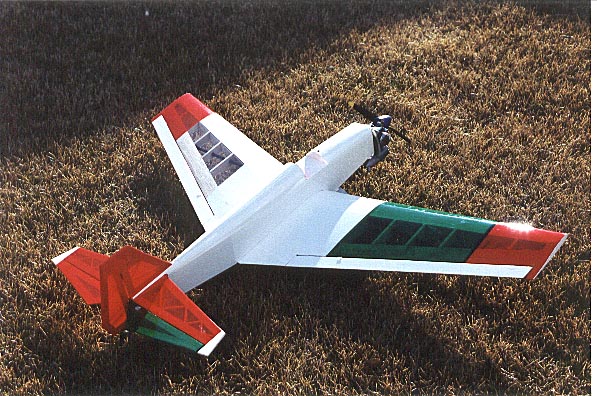
|
Low quality video (1MB) higher quality video (6MB) I crashed the SuperSportster, so I went looking for plans for a plane to build for a .25-sized engine. I'm not at all interested in an ARF, don't want to build a kit, and most plans that aren't for a sailplane well, in my opinion, just aren't that interesting. I just got the Model Aviation issue with a listing of something like 325 plans they have available. If your thing is building old-timers and trainers, you're in luck -- plenty of plans exist for those. Oh -- with maybe a dozen different plans for the Piper Cub and Pietenpol. Not that they're not worth building, it's just not what I want to build now. What I really wanted to build was a forward-swept-wing Zagi. Turns out that might be kinda hard to do after I determined where the CG would have to be. However, after the crash, one of the guys at the field suggested I put my 0.25 on the Zagi. Well -- turns out NASA built the X29 with a forward-swept wing several years ago, citing some good flying characteristics, but not without some technical challenges in the wing structure department. Well, how about that for the start for model? We can overbuild models structurally with carbon-fiber, etc -- so I'm not too worried about this. What I hope to end up with is a model that has a forward-swept wing that flies reasonably well. Ok, I hope to end up with a model with a forward-swept wing that flies. Here are some features:
30 October 2001 I'm now done with the wing, but here are some pictures taken during the building process. Note that I'm using another carbon fiber arrow shaft for a main spar, along with top and bottom conventional spars which are laminated with carbon fiber for strength. I'm also using a mix of truss-type and plate shear webbing. Dihedral is generated by the relative vertical placement of the ribs on the main spar. The wing has the same size ratios as my zagi wing, but it's, um, backwards.
And for now, I'm wondering if an 0.25 will fly this thing? Or is that just an excuse to put a 60 on it? 11 Feb 2002 Pretty much done. Just need to attach the tailwheel and cover it. Finally, a plane designed the way that _I_ would have done it. Didn't even take that long. Pictures will follow...
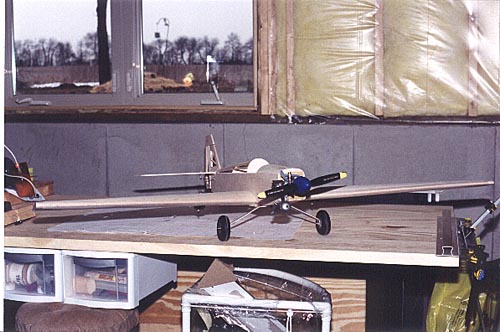
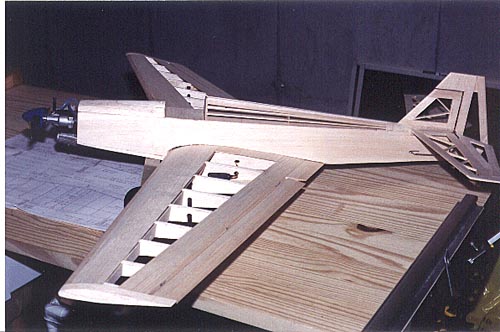
Here you can clearly see the amount of forward sweep on the plane. The CG is just ahead of the LE at the wing root.
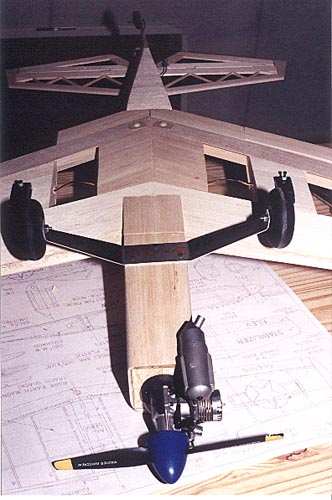
Bottom view of the plane. I chose to mount the wheels on the fuselage, ahead of the CG to make a taildragger. These are just from the hobby shop and looked to be about the right size. A 10-cent piece of aluminimum with a $3.50 bend. The OS .25FP is side-mounted so the muffler points down. I really like this arrangement because it's easier to adjust the high-speed needle and if you're daft enough to flood it, it drains all by itself. Same thing for end-of-day fuel residue. Wing is held on with two nylon bolts and two forward pins into a 1/4" ply former in the fuselage.

In the upright-view, you can see that I made the top hatch removeable. The front holds in with a ply plate, the rear has a single blind nut. The hatch is not structural. This makes dealing with the fuel tank really easy. I also set up the fuel tank with extra long brass tubing -- the brass tubing exits the firewall and comes within 1" of the carb on the engine. Now, if there's an air leak in the fuel tubing, there's only one inch that can do the leaking. I'm using a Sullivan SS-6 slant tank. Having tried the other brands of fuel tanks, in my opinion, this is the best. And it's not like they even cost more than the others.
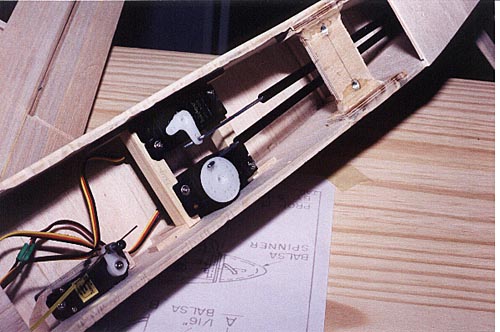
The guts of the plane. I made carbon fiber pushrods for the elevator and rudder, and use z-bends directly to the servo horns. The mini-servo up front is for the throttle. That is the only place I'll use ez-connectors.
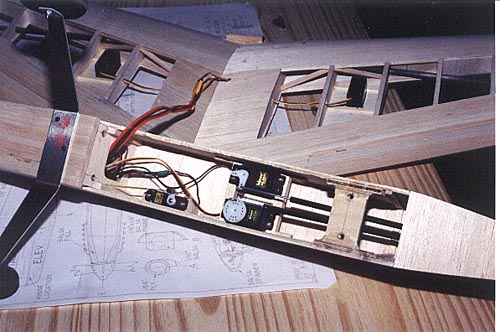
Another view inside. Here, you can see the "H-unit" with the blind nuts for the wing hold down. The receiver is located just ahead of the firewall, up with the fuel tank. Another thing I do in all of my fuel-powered planes is to encase the fuel tank, receiver and battery pack in a latex balloon. Yes, I know that's not fuel-proof, however, in the event of a crash, I'm hoping it can contain fuel in the tank, and keep the receiver and battery dry for the 3-4 minutes it takes me to find the plane. I have not yet had a chance to test this idea, and hope I don't get one. Besides, it does a nice job of keeping the foam tight around the receiver and battery.
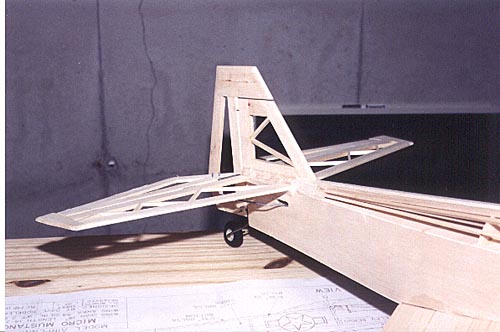
A close-up of the tail. Yes, there is a lot of tail surface.
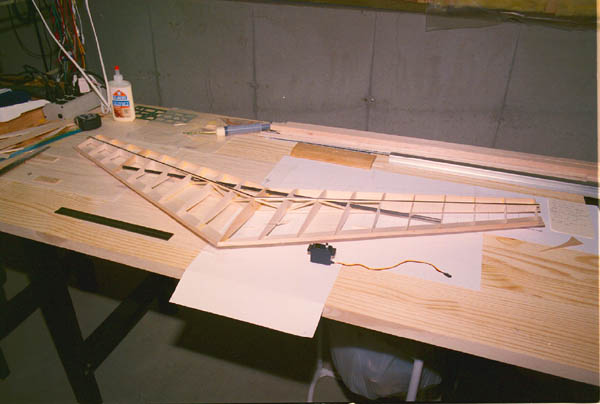

You can see the wing structure well in the previous two pics. The straight black tube is a Carbon Express CX400 carbon fiber arrow shaft. It provides a significant amount of strength to the wing. You can also see that there is generous leading-edge and trailing-edge sheeting, along with 1/4" caps on all exposed ribs. Oh yeah, I also have a 1/4" strip of .007 carbon fiber laminated to the top and bottom of the main spar. That doesn't hurt either. I have a servo mounted in each half of the wing for aileron actuation. The first three inner wing bays use a truss-type shear web, with all the remaining to the tip using a plate-type shearweb. It's a strong wing, and doesn't weigh much.
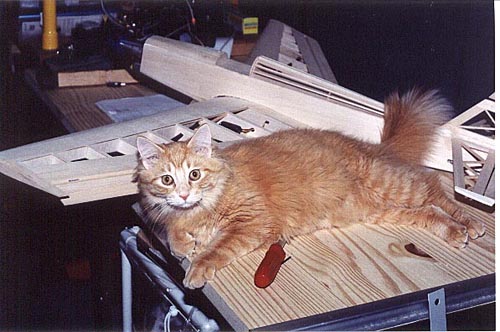
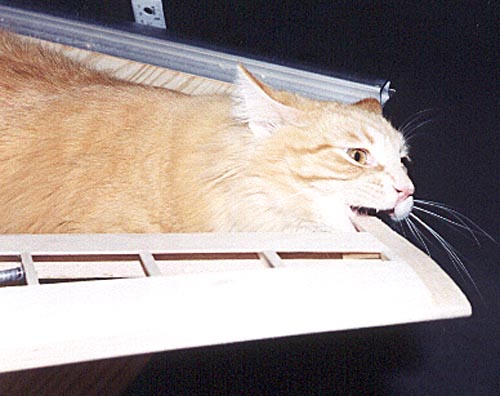
"Mmmm...I like wings..." There have been requests for plans for this plane. Trust me, there's nothing I'd like more than to be able to provide them. However, I need to find out if the plane flies first! If the plane flies, and if there are no major changes needed, then I'll work on drafting up a set and getting them ready to distribute. I won't take advance orders, but if you send me e-mail, I will mail you back (even if it's a year from now) when they're ready. And besides, I like to hear that people are looking at the site. UPDATE: Sat 14 Sep 2002 -- it flies! After getting the engine started (I needed to replace the glowplug) I had the first and second flights. The plane was a bit squirrely on the first flight due to amount of ailieron throw I had available. Nevertheless, it was controllable. The engine was needed some tweaking, and the first landing was off the field, but was a slow wheels-down flat landing. No damage. The second flight had the advantage of a better-tuned engine and dual rates set for the ailerons. There's something strange about the rate of decent for the plane -- you can slow it down and pull back on the elevator and it just decends -- without pitching or stalling. Second landing was short and on the field. Next step: picture for "Model Aviation", plans and then an article for Model Aviation. A non-standard configuration that so far seems to fly surprisingly well, if at all.
Saturday 05 October 2002: more flying. The hardest thing about flying the plane is keeping in mind what you're doing and where the plane is going. It doesn't look "right" in the air -- it's easy to get disoriented. It's not hard to recover, however. November 21 -- end of season End of season -- maybe. It's a bit too cold on the fingers to fly these days. In any case, some thoughts on the flying characteristics of this plane. Considering I've built an unstable platform, it's not only controllable, but fun to fly. When turning, the location of the CG is very apparent -- all yaw and pitch seems to happen through that point. Rolls aren't pretty, loops are fine. The plane does prove to be very stall-resistant. For an interesting landing, come in about 30' over the runway, cut the throttle and apply full up elevator. The plane will proceed to decend at a 60 degree angle with no adverse pitch or roll. The plane will drop in, with engine running and NO landing roll. You do need to keep the wings level with aileron, but it's no worse than any other landing. The plane isn't particularly fast, which is most likely a good thing. I don't know that I'll make any changes to this plane this winter -- other than securing the engine cowl to the fuselage, perhaps. Wow, wouldn't a .60-sized be fun? :) last modified Fri Nov 22 22:23:47 CST 2002 by timc! |